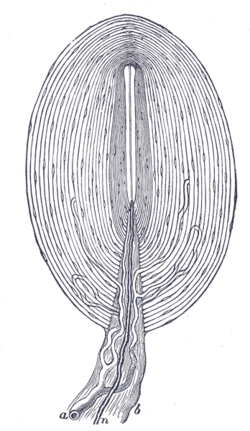Pacinian corpuscle end-organs
| Lamellar corpuscle | |
|---|---|

Lamellar corpuscle, with its system of capsules and central cavity.
a. Arterial twig, ending in capillaries, which form loops in some of the intercapsular spaces, and one penetrates to the central capsule. b. The fibrous tissue of the stalk. n. Nerve tube advancing to the central capsule, there losing its white matter and stretching along the axis to the opposite end, where it ends by a tuberculated enlargement. |
|

Lamellar capsule labeled at bottom
|
|
| Details | |
| Identifiers | |
| Latin | corpusculum lamellosum |
| MeSH | A08.800.550.700.500.700 |
| Code | TH H3.11.06.0.00009 |
| TH | H3.11.06.0.00009 |
| FMA | 83604 |
|
Anatomical terminology
[]
|
|
Lamellar corpuscles, or Pacinian corpuscles, are one of the four major types of mechanoreceptor cell in glabrous mammalian skin. They are nerve endings in the skin responsible for sensitivity to vibration and pressure. They respond only to sudden disturbances and are especially sensitive to vibration. The vibrational role may be used to detect surface texture, e.g., rough vs. smooth. Lamellar corpuscles are also found in the pancreas, where they detect vibration and possibly very low frequency sounds. Lamellar corpuscles act as very rapidly adapting mechanoreceptors. Groups of corpuscles respond to pressure changes, e.g. on grasping or releasing an object.
Lamellar corpuscles are larger and fewer in number than Meissner's corpuscle, Merkel cells and Ruffini's corpuscles.
The Lamellar corpuscle is approximately oval-cylindrical-shaped and 1 mm in length. The entire corpuscle is wrapped by a layer of connective tissue. Its capsule consists of 20 to 60 concentric lamellae including fibroblasts and fibrous connective tissue (mainly Type IV and Type II collagen network), separated by gelatinous material, more than 92% of which is water.
Lamellar corpuscles are rapidly adapting (phasic) receptors that detect gross pressure changes and vibrations in the skin. Any deformation in the corpuscle causes action potentials to be generated by opening pressure-sensitive sodium ion channels in the axon membrane. This allows sodium ions to influx, creating a receptor potential.
These corpuscles are especially susceptible to vibrations, which they can sense even centimeters away. Their optimal sensitivity is 250 Hz, and this is the frequency range generated upon fingertips by textures made of features smaller than 1 µm. Lamellar corpuscles cause action potentials when the skin is rapidly indented but not when the pressure is steady, due to the layers of connective tissue that cover the nerve ending. It is thought that they respond to high-velocity changes in joint position.
...
Wikipedia
